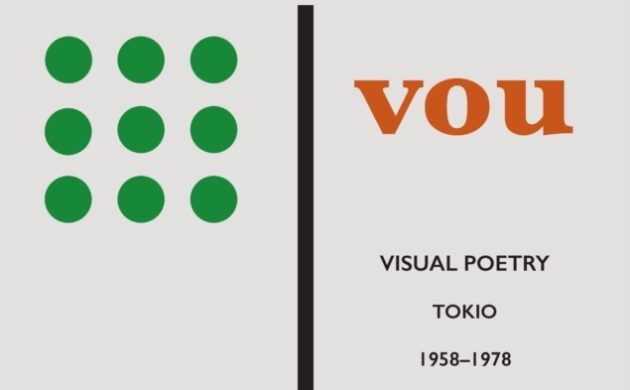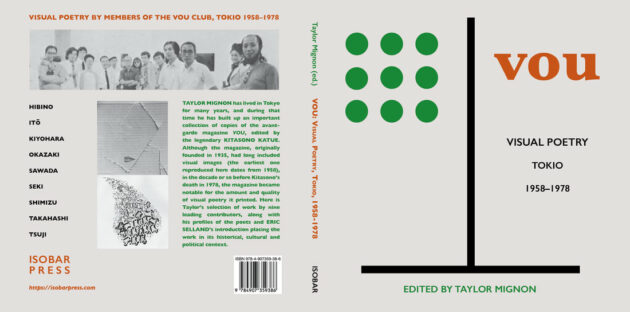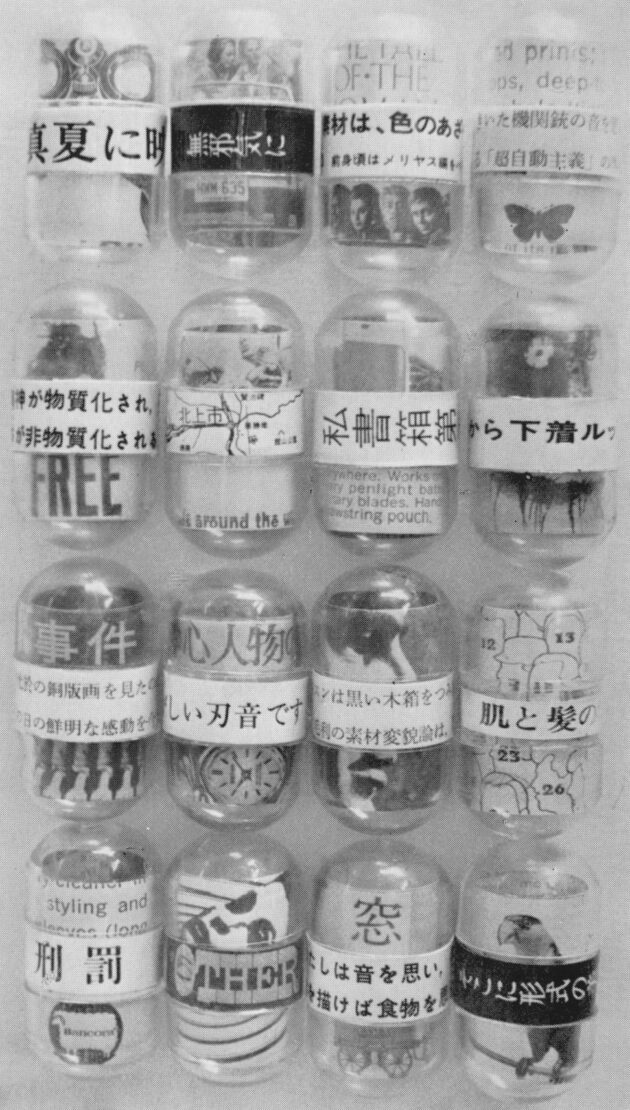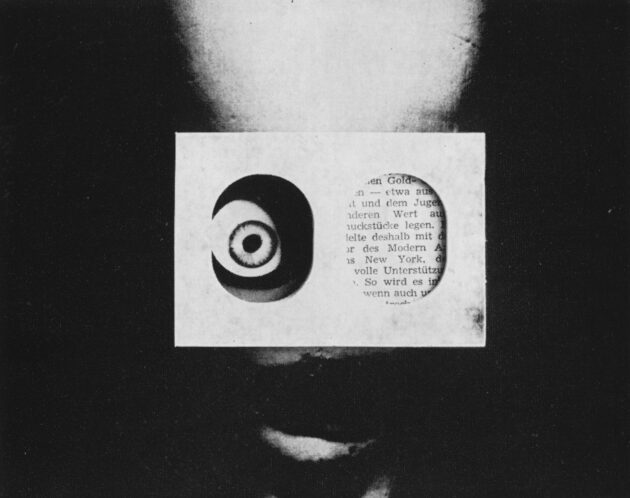
VOU: Visual Poetry, Tokio, 1958-1987. Edited by Taylor Mignon. Introduction by Eric Selland. Tokyo: Isobar Press. 120pp., ¥3,057 (paper).

This anthology, VOU, presents striking visual-poetry (often called “vispo,” by practitioners). Visual-poetry combines visual art and poetic sensibility by manipulating images and letterforms. It’s sassy, cheeky, and sometimes three-dimensional. Vispo is fluid, non-semantic expression that’s beyond the poetic conventions of renga, tanka, waka, haiku, or chōka. The VOU anthology showcases some of Japan’s finest avant-garde artists. Artists in this anthology have earned international reputations, showing and publishing their creations world-wide. For example, Takahashi Shōhachirō took part in a debate about visual-poetry at Yale University and presented works at the “Artword” exhibition (Museum of Modern and Contemporary Art; Bolzano, Italy), which included internationally recognized artists, such as Dick Higgins. Forerunners among international periodicals featuring visual-poetics include Kaldron, Rampike, and Otolithts.
Visual-poets in VOU were inspired by earlier creators including Hagiwara Kyōjirō (1899-1938), and Kitasono Katue (1902-1978). Kitasono, a Surrealist and Dadaist, established the VOU Club (1935). He corresponded with internationally recognized poets and writers including Ezra Pound, Haroldo de Campos, and Kenneth Rexroth. Recently, Jacket 2 published an engaging article by eminent poet, Jerome Rothenberg, showcasing Kitasono, with translation and notes by John Solt.

VOU experienced delays before publication. The editor, Taylor Mignon, researched Japanese vispo and corresponded with US publisher, Karl Young. They exchanged ideas and materials, but Young’s death complicated matters. Mignon finally recovered VOU’s materials, but funding remained an issue until publisher Paul Rossiter (Isobar Press) made VOU a marvellous reality.
VOU offers nine dynamic visual-poetic artists. Most were active in the Anpo Protests. Eric Selland’s introduction provides historical context, informing us that VOU members followed luminary Shuji Terayama’s advice about adopting alternate life-styles. The VOU group explored earlier international visual-poetry, including Apollinaire’s Calligrammes (1918). Mignon’s poets’ biographies provide informative backgrounds. His Afterword offers additional historical context. A helpful bibliography is provided for further investigation.

VOU poets pursue ideas, limit words and probe primal experiences by contrasting conformity with free-thought. Their roots lie in Surrealism, Dadaism, Concretism and Lettrism. In Japan, pioneers include Noda Naotoshi, Kitasono Katue, and Seiichi Niikuni, among others.
I admire all the VOU artists. I’ll comment on several. Seki Shiro’s “poème ligné: un voyant” offers minimalist abstraction by juxtaposing target-like concentric circles and a human like figure with a single eye. Seki Shiro raises questions about perception and relationships of viewers (“voyant[s]”) regarding the target of artistic expression. The simple line-geometrics stand in contrast to complex questions aimed at audiences about their role interpreting visual-poetry.
I was intrigued by Itō Motoyuki’s “capsule plan 3.” He is a contemporary of Takahashi Shōhachirō with whom he has collaborated. Have you ever “bottled-up” your feelings? Itō gathers words inside glass jars. He contrasts momentary thought with timeless preservation.

Widely published jazz specialist Shimizu Toshihiko’s collages appear on covers by the Stan Tracey Sextet and the Masahiko Togashi Trio. Japanese letterforms in his “anti-illusion 2” make subtle jazz references. “Anti-illusion 2” uses “misdirection,” a technique favoured by magicians. It asks whether audiences are factors in generating meaning, and whether artistic creation is superfluous. His images within images create jazz-like echoes. “Anti-illusion 2” embeds the words “Les Pas Perdus” (“steps lost”) recalling Surrealist and Dadaist fundamentals. The result is a jazzy visual magic which asks viewers to question their roles whenever observing artistic expression.
Tsuji Setsuko reveals the influence of her mentor Kitasono Katue. She edited O magazine, which featured several VOU poets. Her “photo poem” contrasts two eye-holes against an odd head-like background. From one hole an eyeball regards the viewer, but a second eye-hole contains obscured German text mentioning visual-art, support structures, and theory. This visual-poem abandons supportive art theory. Viewers must ponder indefinability. Renewing Surrealist and Dadaist techniques, Tsuji Setsuko’s artistry teases audiences with delicious and tempting mysteries.


Karl Jirgens, (Prof. Emeritus, U Windsor) founded/edited/published Rampike Magazine. His newest book is The Razor’s Edge (Website: www.jirgens.org). Recently, he guest-edited HA&L magazine featuring numerous visual-poetic creations: https://samizdatpress.typepad.com/hal_issue_fifteen-2/hal-magazine-issue-fifteen2-cover.html
Images courtesy of Isobar Press
Advertise in Kyoto Journal! See our print, digital and online advertising rates.
Recipient of the Commissioner’s Award of the Japanese Cultural Affairs Agency 2013